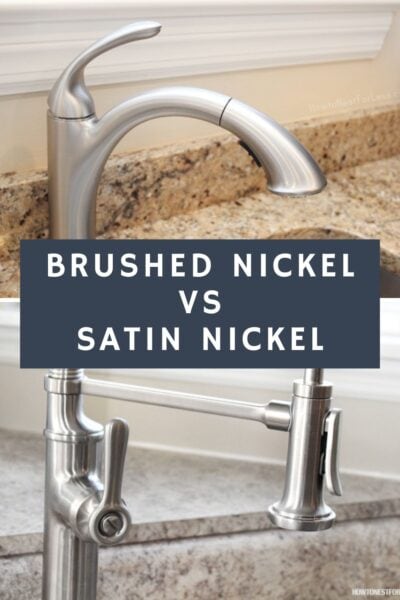Are you standing in the hardware aisle, staring at a sea of finishes, and feeling overwhelmed? You’re not alone.
Choosing the right finish for your home can be a daunting task, especially when faced with options like satin nickel and brushed nickel. These two popular finishes may sound similar, but they can have a significant impact on the look and feel of your space.
Imagine the sleek elegance of satin nickel complementing your modern decor, or the subtle texture of brushed nickel adding depth to your traditional style. Each finish has its own unique charm, and understanding the differences can help you make the best choice for your home. You’ll discover the key distinctions between satin nickel and brushed nickel. You’ll learn how each finish can influence the ambiance of your rooms and how to make a decision that aligns with your personal style. Get ready to transform your space with confidence!
Satin Nickel Characteristics
Satin nickel is a popular choice for home fixtures. It offers a smooth and elegant appearance. This finish is known for its subtle charm. Its versatile nature makes it suitable for various styles. Let’s explore the characteristics of satin nickel.
Smooth And Lustrous Surface
Satin nickel has a soft sheen. It doesn’t shine too brightly. The finish creates a warm, inviting look. It fits well with modern and classic designs. A satin surface feels smooth to the touch.
Durability And Resistance
This finish is durable. It resists scratches and fingerprints. Satin nickel maintains its beauty for years. Its resistance makes it ideal for high-use areas. Quality and strength define satin nickel.
Versatile Design Compatibility
Satin nickel pairs with many color schemes. It blends well with dark and light tones. Its neutral shade complements wood and metal. Satin nickel enhances any room’s decor. It’s adaptable and stylish.
Easy Maintenance
Cleaning satin nickel is simple. A soft cloth keeps it shining. Regular care ensures lasting elegance. It requires minimal effort to maintain. Satin nickel stays beautiful with little fuss.
Affordability
Satin nickel is cost-effective. It offers luxury without high expense. Many homeowners prefer its affordability. Satin nickel provides value and style. It’s a smart choice for budget-conscious buyers.
Brushed Nickel Features
Brushed nickel is a popular choice in home design for its subtle elegance. This finish offers a sophisticated look without being too shiny or flashy. It works well in various design styles, adding a timeless touch to spaces.
What Is Brushed Nickel?
Brushed nickel is a metal finish that is created by using a wire brush or similar tool. The brushing process gives the nickel a textured surface. This texture reflects light softly, creating a warm, muted glow.
Durability Of Brushed Nickel
Brushed nickel is known for its durability. The textured finish helps hide fingerprints and water spots. This makes it ideal for busy spaces like kitchens and bathrooms. Its resistance to wear ensures it looks great for years.
Color And Appearance
Brushed nickel has a warm, silver tone. It complements many color schemes, from cool blues to warm earth tones. The finish’s soft glow adds depth and interest to fixtures.
Easy Maintenance
Maintaining brushed nickel is simple. Regular cleaning with mild soap and water keeps it looking new. It does not require special polishes or treatments, which saves time and effort.
Versatility In Design
Brushed nickel suits various design styles, from modern to traditional. Its understated elegance blends seamlessly with other materials. Whether in fixtures or accents, it enhances room aesthetics.
Visual Differences
Satin nickel offers a smooth, consistent look with a subtle shine. In contrast, brushed nickel reveals a textured appearance with visible brush strokes, creating a more matte finish. Both finishes add elegance to home décor, each providing a distinct visual effect.
When choosing finishes for your home fixtures, understanding the visual differences between satin nickel and brushed nickel can be a game-changer. These finishes might seem similar at first glance, but they each offer unique characteristics that can dramatically impact the look and feel of your space. Let’s dive into what sets these two apart, focusing on their color and texture, as well as their reflective qualities.Color And Texture
Satin nickel tends to have a slightly warmer tone compared to brushed nickel. This subtle warmth can create a cozy atmosphere, perfect for spaces where you want to add a touch of elegance without overwhelming the senses. In contrast, brushed nickel offers a cooler, more industrial vibe. It often works well in modern settings where sleekness and simplicity are desired. The texture of brushed nickel is achieved through a distinctive brushing process, giving it a linear, textured appearance that can add depth to the overall design. Consider how these colors and textures might complement other elements in your room. Do you prefer a warm, inviting feel, or are you aiming for a sleek, contemporary look? Your choice can significantly influence the ambiance of your space.Reflective Qualities
Reflective qualities can play a crucial role in how light interacts with your fixtures. Satin nickel has a softer, more diffused reflection. This can be ideal for areas where you prefer a gentle glow rather than a sharp, direct light. Brushed nickel, on the other hand, reflects light in a more subdued manner due to its textured surface. This can minimize glare and create a more understated, sophisticated look. If you’re designing a room with a lot of natural light, brushed nickel might help control the brightness. Think about the lighting conditions in your home. Do you want your fixtures to catch the eye with a soft sheen, or do you prefer them to blend seamlessly into the background? Each finish offers different possibilities for manipulating light. Choosing between satin nickel and brushed nickel isn’t just about aesthetics—it’s about how you want your space to feel. Which qualities resonate with your personal style?Durability And Maintenance
Choosing between satin nickel and brushed nickel finishes involves understanding their durability and maintenance. These finishes not only add aesthetic appeal but also have practical aspects to consider. Knowing how they withstand wear and tear can help in making an informed decision.
Scratch Resistance
Satin nickel offers moderate resistance to scratches. Its smooth surface may show minor marks over time. Brushed nickel, with its textured surface, tends to hide scratches better. The brushed texture disperses light, minimizing visibility of marks.
Cleaning And Care
Cleaning satin nickel requires gentle methods. Use mild soap and water to preserve its luster. Brushed nickel is more forgiving with cleaning. Its textured finish can handle slightly abrasive materials without damage.
Avoid harsh chemicals on both finishes. They can dull the surface over time. Regular cleaning helps maintain their appearance and longevity.
Cost Comparison
Choosing between satin nickel and brushed nickel finishes involves cost considerations. Each finish offers unique aesthetics and durability. Price plays a significant role in decision-making. Understanding the cost differences can help make an informed choice.
Price Range
Satin nickel often falls in the mid-price range. It offers a refined look without breaking the bank. Brushed nickel usually costs slightly more. This is due to its texture and manufacturing process. The price difference is generally small. Both options are affordable for most budgets.
Value For Money
Satin nickel provides excellent value. It combines elegance with affordability. Its finish is durable and long-lasting. Brushed nickel also offers good value. Its unique texture adds a touch of luxury. It stands up well to daily wear.
Both finishes provide great returns on investment. Their durability and style enhance any space. Choosing between them depends on personal preference and budget. Weighing the cost against the desired aesthetic can guide the decision.

Credit: lookintheattic.com
Popular Applications
Understanding the popular applications of satin nickel and brushed nickel helps make informed choices. These finishes offer unique styles and benefits. They fit different settings and preferences. Let’s explore their common uses in both home and commercial spaces.
Home Interiors
Satin nickel often adorns home interiors due to its warm, inviting look. It complements modern and traditional decor styles. Kitchen and bathroom fixtures are popular choices. Satin nickel provides a soft, subtle shine. This finish reduces the appearance of fingerprints and smudges.
Brushed nickel, with its matte texture, suits minimalist designs. It provides a sleek, contemporary feel. Many homeowners prefer it for door handles and cabinet hardware. Its resistance to tarnish and corrosion offers long-lasting beauty.
Commercial Spaces
In commercial spaces, both finishes provide functional elegance. Satin nickel adds a touch of sophistication to office environments. It works well in conference rooms and reception areas. Its ability to blend with various color schemes is a plus.
Brushed nickel is favored in high-traffic areas. Its durability and low maintenance make it ideal. Retail stores and restaurants often use it for fixtures. Its non-reflective surface provides a professional look.
Style And Aesthetics
Choosing between satin nickel and brushed nickel finishes can be tricky. Each offers a distinct look and feel. The style and aesthetics of your space play a crucial role. Both finishes can transform the appearance of a room. Let’s dive into the differences and see which suits your style best.
Modern Vs. Traditional
Satin nickel gives a sleek and smooth appearance. It works well in modern spaces. The soft sheen adds elegance without being too shiny. Brushed nickel has a more textured look. It fits well in traditional or rustic settings. The subtle lines give it a handcrafted feel.
Complementary Colors
Satin nickel pairs well with cool tones. Think blues, greys, and whites. These colors enhance its smooth, modern look. Brushed nickel complements warm tones. Earthy colors like beige, brown, and olive green work well. They highlight its textured, traditional charm.
Environmental Impact
Satin nickel and brushed nickel finishes are popular in home decor. Both offer distinct styles and durability. Yet, their impact on the environment often gets overlooked. Understanding their environmental footprint helps in making informed choices. Let’s explore their environmental impact through their manufacturing process and recyclability.
Manufacturing Process
The manufacturing of satin nickel involves electroplating. This process uses chemicals and energy. It creates a smooth, shiny finish. The energy consumption can be significant. Additionally, chemical waste is a concern. Proper disposal is necessary to avoid pollution.
Brushed nickel finishes use a different technique. It involves brushing the nickel surface with a tool. This creates a matte appearance. This method uses less energy compared to electroplating. However, it still requires careful handling of materials. Waste management is crucial in both processes to minimize harm.
Recyclability
Nickel is a recyclable material. Both satin and brushed nickel can be recycled. Recycling helps reduce the need for new materials. This conserves resources and minimizes environmental impact.
The recycling process involves melting down the metal. This uses less energy than creating new nickel. Recycled nickel maintains its quality and properties. Encouraging recycling can lessen landfill waste. It also supports a more sustainable cycle in home decor.
User Preferences And Trends
Choosing between satin nickel and brushed nickel can be confusing. Satin nickel offers a smooth, elegant look with a slight sheen. Brushed nickel provides a more textured, matte finish, popular for contemporary styles. Consider your personal taste and home decor trends when deciding.
When choosing between satin nickel and brushed nickel finishes, user preferences and trends play a significant role. Your choice might be influenced by personal taste, practical needs, or even what’s trending in the market. Let’s dive into what other consumers are saying and what the current market trends reveal.Consumer Feedback
Many homeowners share their love for the sleek, modern look of satin nickel. It’s often praised for its smooth texture and ability to blend well with contemporary décor. You might find that satin nickel is less likely to show fingerprints, which is a big plus for families with children. On the other hand, brushed nickel often receives compliments for its classic, timeless appeal. Its subtle texture can hide scratches and water spots better than satin. If durability and ease of maintenance are your priorities, brushed nickel might just win your vote. Have you ever wondered why some people swear by one finish over the other? Personal experiences, like how a finish looks under different lighting or matches with other home elements, heavily influence these choices.Current Market Trends
The market reflects a growing demand for both finishes, though trends can fluctuate. Satin nickel has gained popularity in minimalist and modern home designs. Its subtle shine adds a touch of elegance without being overpowering. Brushed nickel, however, remains a steadfast choice in traditional and transitional styles. Its matte finish provides a warm, inviting feel that many find appealing. Is it possible that the rise of eco-friendly and sustainable home trends affects your choice? Both finishes are available in eco-friendly options, catering to the environmentally conscious buyer. Considering user preferences and market trends, which finish would you lean towards for your home?
Credit: www.berensonhardware.com

Credit: howtonestforless.com
Frequently Asked Questions
What Is Satin Nickel Finish?
Satin nickel is a smooth, matte finish. It reduces glare and fingerprints. Popular in modern design.
How Does Brushed Nickel Differ From Satin?
Brushed nickel has visible brush strokes. It offers a more textured look. Less shiny than satin nickel.
Which Finish Is Easier To Maintain?
Both finishes are easy to maintain. Satin hides fingerprints better. Brushed is less prone to showing wear.
Is Satin Nickel More Expensive Than Brushed?
Costs can vary. Satin nickel might be slightly pricier. Depends on brand and quality.
Which Finish Suits Modern Decor Better?
Satin nickel suits modern decor well. Its sleek look matches contemporary styles. Brushed nickel fits traditional spaces.
Conclusion
Choosing between satin nickel and brushed nickel depends on your style preference. Satin nickel offers a smooth, modern look. Brushed nickel provides a textured, classic appearance. Both finishes are durable and easy to maintain. Consider the lighting in your space.
It can affect how each finish looks. Think about existing fixtures and hardware. Matching finishes can create a cohesive design. Ultimately, both options enhance your home beautifully. Make your choice based on the overall aesthetic you desire. Your personal taste will guide you to the perfect finish.
Enjoy the elegance these finishes bring to your space.





